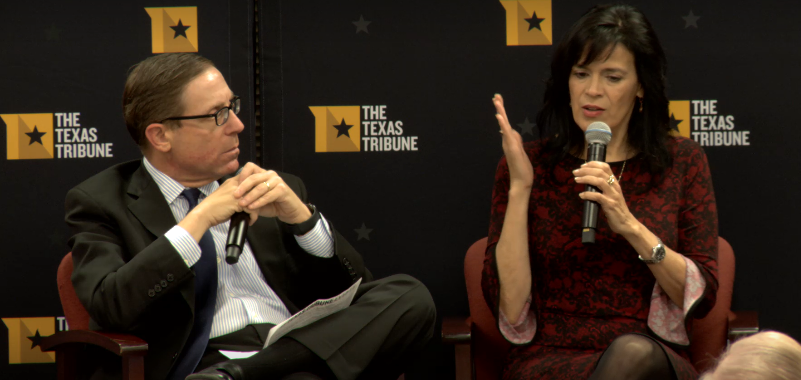EL PASO, Texas (Border Report) — When it comes to commerce, the border is a bridge — not a wall — and right now that bridge is too small, understaffed and sans the technology to provide both security and faster cargo inspections.
“Our ports from Santa Teresa to Tornillo are in bad need of upgrading,” said El Paso industry advocate Jon Barela. “We need to work in a concerted fashion to get more personnel at these ports of entry. We need to deploy — and fast — technology, and we need infrastructure: more lanes, more ports.”
Barela, chief executive officer of The Borderplex Alliance, spoke Thursday at the Texas Tribune’s “Future of the Border Region” conference at the University of Texas at El Paso. It was one of five panels meant to give a Texas and nationwide internet audience a glimpse of politics, culture and the economy of the El Paso-Juarez border.
Some pillars of that economy are the hundreds of manufacturing plants in Juarez that send billions’ worth of assembled goods and parts to parent companies in the United States. So are thousands of Mexican shoppers who frequent El Paso malls and Downtown shops.
Both those streams of income come across international bridges that already seemed overwhelmed before last year’s migrant crisis forced inspectors at border crossings to be reassigend to detention facilities.

“We are operating at 60 percent,” said Miriam Baca Kotkowski, president of Omega Trucking company. “We have eight commercial lanes at Ysleta (border crossing) and, how many are open? Four. We have six lanes at (Bridge of the Americans) and, how many are open? Three. What I hear is that it’s lacking of personnel.”
According to various members of Congress in the Southwest, U.S. Customs and Border Protection (CBP) is short between 1,000 and 3,000 officers to fully staff the nation’s 50 or so land border crossings. The delays don’t just affect border communities and businesses, but also the many Fortune 500 companies that have manufacturing operations in Mexico and need their products right way, speakers said.
“The staffing levels are not what they need to be. I have conveyed this to the White House and elsewhere. We need at least 200 more officers,” said El Paso Mayor Dee Margo, who’s taken his case to Washington, D.C., with limited success.
“We got $32 million for technology, but that was from the state (Texas),” he said.

In fact, El Paso is paying CBP nearly $1 million a year to cover overtime costs for bridge officers, so that inspection lanes can remain open additional hours, he said.
U.S. Rep. Veronica Escobar, D-Texas, announced on Thursday she would be arranging a field hearing in El Paso over the economic impact of border wait times.
For businessmen like Julio Chiu, founder and CEO of Seisa Group, which manufactures precision medical equipment in Juarez, more CBP staffing can’t come soon enough.
“We used to be able to get (trucks) across four times a day, then during the (migrant crisis) we were down to one a day. Even when you’re down to two or two and a half, it has a direct cost to your operations,” Chiu said.
Barela added that border security and getting commercial trucks across the border faster are not incompatible. “We need to deploy technology, which by the way, secures the border and promotes trade,” he said.
The House has passed bills calling for the purchase of more portable X-ray machines and other types of non-intrusive inspection (NII) technology, which are pending Senate consideration. One bill passed last year by both houses provided half a billion dollars in funding for NII, but most of that money remains unspent, the lawmakers said.
















